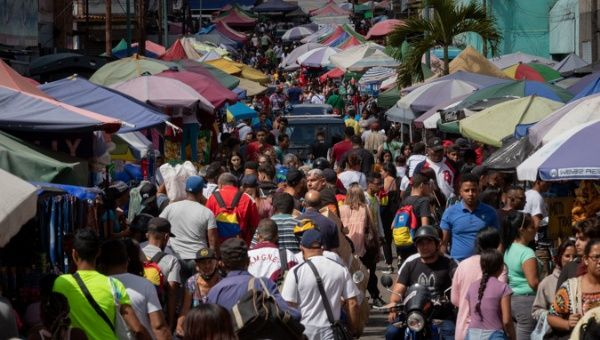
People shop on busy Catia Boulevard in Caracas | Photo: EFE
Caracas, January 2 (RHC)-- The United Nations Economic Commission for Latin America and the Caribbean, known as ECLAC, and the International Monetary Fund (IMF) are forecasting that in the context of a Latin American growth of 3.5%, Venezuela will increase its GDP by 5% to 6.5% next year. Other predictions speak of up to 10% growth for Venezuela, even without substantial improvements in the sanctions imposed against it.
With a growth of 12% by the end of 2022, according to the same organizations, and a substantial improvement in inflation and devaluation with respect to the year before, these figures sound plausible. The main levers for Venezuela to follow the path of recovery in the context of a world economic recession derive from the difficult geoeconomic and geopolitical situation the world is going through.
The Russia-Ukraine war, the threat of conflict between China and Taiwan, as well as the political instability in the Middle East are pushing the U.S. and Europeans to see Venezuela as a source of energy for the coming year.
However, the decrease in demand due to the contraction of consolidated economies is expected to keep oil prices around $80 U$D per barrel in 2023. This is because Russia -- traditionally the world's largest oil exporter -- will continue to be subject to the international veto imposed by NATO countries. This will determine that the balance between the supply and consumption of crude oil will remain in deficit as it is today.
As a result of the above, OFAC issued license 41 for Chevron to restart its operations in Venezuela. Likewise, it is expected that during the coming year, the multinationals Eni and Repsol, and perhaps many others, will obtain similar authorizations to "start up" the exploitation and export of oil in Venezuela.
According to the Venezuelan Oil Chamber, doubling the current oil production of 700,000 barrels per day would require an investment in working capital of, at most, 20,000 million dollars during 18 months. By the end of 2023, the national government will most likely achieve the production goal of 1 million barrels per day, which would almost double the nation's oil export revenues.
Remittances, currently estimated at U.S. $ 4.2 billion, added to exports of gold and other minerals and, to a lesser extent, exports of non-traditional items, could contribute to the trade balance. By 2023, some US$ 20 billion are expected to enter the country through exports, substantially higher than the US$ 15 billion estimated for the end of this year.
2022 closed with inflation close to 180% and a devaluation of 240%, which, although very tough, are substantially lower than the 600% inflation and 400% devaluation observed in 2021. In 2023, most analysts agree that inflation and devaluation will be close to 80%, provided the government maintains the fiscal discipline and exchange rate intervention policies that have characterized it this year.
The scenarios indicated are conservative since they do not consider significant national or international political changes, which would encourage OFAC to accelerate the easing of the sanctions, which are currently strangling the country. Nor do they include possible benefits from the opening of bilateral relations with Colombia and Brazil and the initial flirtations with the Andean Community and Mercosur.

